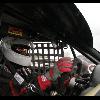I made the same mistake. I thought to myself, "what is this guy talking about?" until i re-read his original post.
PSL sounds like a great idea. But can it really be $25k assembled? For the things mentioned in the document, It might work. But it seems initial buy in costs will creep with data acquisition, and GPS dashboards, setup. The upfront costs, theoretically, are low. But what about setup and testing time? With a fully adjustable suspension, the real sharp guys will be able to gain a significant advantage through tuning and testing time, further driving the cost overall to be competitive. I would suggest keeping the springs sway bars and dampers spec. This will tighten the competition, and add to the spectacle. I hate watching prototype cars drive alone at all the events I go to.
With minimal down force, the need to adjust the suspension is also limited, making spec suspension parts more feasible.
The spreadsheet does have a note that class PSL does not yet exist.
The concept of this car (or the open-wheel version at least) has been discussed ad nauseum for many years over at apexspeed.com. Here are some links if you feel like wasting a few days of your time. Formula D, Open Wheel Miata, Phoenix FS FS600, The cheapest practical SR2, Entry Level Formula Car, and FS1000 Scalable to FB, P3. The cars have been called "FD", "Formula Super 600", and "FS1000".
There are several builders who've said they can build this car for the target price, in the right quantity. The trick will be to get them to standardize on parts, so racers can share parts at the track. The builders would differentiate by their chassis, suspension geometry, body-work, etc. Similar to how it works with FV and FST.
One builder I've had some discussion with, Jay Novak, is building a P2 car for a target price of $35,000. He has a long record of producing inexpensive but quality race cars, so I believe he can do it. Check out his F600, which he sold as an assembled roller for $22,000. He's also built P2 cars before. He will be displaying his new P2 car next week at the Run-offs. Remove the wings, diffuser, use smaller wheels, cheaper shocks, and I think it can be done for $30,000.
As far as set up and testing, I'll pay for that myself and share everything I learn. I'm an open-source software developer, so I believe we all have more fun for less money when we share what we know. I will start a community (forum + wiki) where we document what works. We will spec many parts, including inexpensive shocks with recommended valving--so no $10,000 triple-adjustable shocks. We will test and share recommended set-ups, so people don't have to spend a lot on testing. Practice is still a good idea though! I am concerned about the cost of data acquisition--need to work on that problem.
The question now is how to bootstrap the market for the car. I will either buy the first kit from Jay or take an obsolete first-gen Stohr sports racer (can be had for about $20k) and put on 13x6 wheels, remove all downforce, change the springs and shocks, and insert restrictors in the engine (or maybe just set the revlimit in the ECU), and demonstrate the car. Take it to track-day events and show people they could be racing for what they're spending to run their street cars in HPDE's.
I have no illusions of getting the SCCA to declare a new class. These cars will run in class ASR in regional races, and the racers themselves will declare finishing places by simply looking at the official results and knowing which cars are PSLs. Once we get enough cars we can run our own series, much like Formula First does. FST does this despite the fact that it is a regional-only class in the SCCA and doesn't go to the Run-offs. To be honest, I really don't care about the Run-offs anymore. So what if the SCCA never declares a new class for this? They can run the events, we will do our own scoring. We'll maintain the rules in our community. We don't need their rules bureaucracy.
Sorry to take the Miata forum so far off topic. It was not my intention, but some folks seemed interested.
Greg




 Sign In
Sign In Create Account
Create Account













 Back to top
Back to top Report
Report





